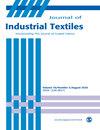Additive technologies use to create structures for technical fabric replacement
IF 2
4区 工程技术
Q1 MATERIALS SCIENCE, TEXTILES
引用次数: 0
Abstract
The production technology of one of the essential structural parts of rubber-textile conveyor belts, the textile carcass, has not changed much since the start of their use. Specific changes occurred only in the material used when various synthetic fibres gradually replaced cotton. However, with the development of additive technologies, the possibility of changing the production technology is coming to the fore, when industrial textiles produced by classic weaving will not be used to make the carcass but a structure built by 3D printing. Confirmation of this change would represent a revolutionary breakthrough in the technology for rubber-textile conveyor belt production. Based on these facts, the possibility of using continuous 3D printing technology was verified to print a structure that would replace the technical fabric used in the conveyor belt carcass. As part of the research, the Selective Laser Sintering (SLS), Fused Deposition Modeling (FDM), and Stereolithography (SLA) technologies were verified. Experimental specimens with the dimensions of 145 x 145 x 185 mm were produced in three different positions: at an angle (45°), horizontally, and vertically. The specimens were made of three types of filament: SLA (Elastic 50A), SLS (TPU 1301), and FDM (Flexfill 92A); for each of the three positions of the specimen, filament consumption and printing time were determined due to the use of support material. Created specimens were then assessed regarding their production possibility and achievement of the desired structure.使用添加剂技术制造技术织物替代结构
橡胶织物输送带的重要结构部件之一--织物胎体的生产技术自开始使用以来一直没有太大变化。只有当各种合成纤维逐渐取代棉花时,所用材料才会发生具体变化。然而,随着添加剂技术的发展,改变生产技术的可能性正逐渐凸显,届时,传统编织法生产的工业纺织品将不再用于制造胎体,而是通过 3D 打印技术制造结构。这一变化的确认将代表着橡胶织物传送带生产技术的革命性突破。基于这些事实,我们验证了使用连续三维打印技术打印结构的可能性,这种结构将取代输送带胎体中使用的技术织物。作为研究的一部分,对选择性激光烧结(SLS)、熔融沉积建模(FDM)和立体光刻(SLA)技术进行了验证。在三个不同的位置制作了尺寸为 145 x 145 x 185 毫米的实验试样:45°角、水平和垂直。试样由三种长丝制成:SLA (Elastic 50A)、SLS (TPU 1301) 和 FDM (Flexfill 92A);由于使用了支撑材料,试样的三个位置的长丝消耗量和打印时间都已确定。然后,对制作出的试样的生产可能性和所需结构的实现情况进行评估。
本文章由计算机程序翻译,如有差异,请以英文原文为准。
求助全文
约1分钟内获得全文
求助全文
来源期刊

Journal of Industrial Textiles
MATERIALS SCIENCE, TEXTILES-
CiteScore
5.30
自引率
18.80%
发文量
165
审稿时长
2.3 months
期刊介绍:
The Journal of Industrial Textiles is the only peer reviewed journal devoted exclusively to technology, processing, methodology, modelling and applications in technical textiles, nonwovens, coated and laminated fabrics, textile composites and nanofibers.
 求助内容:
求助内容: 应助结果提醒方式:
应助结果提醒方式:


